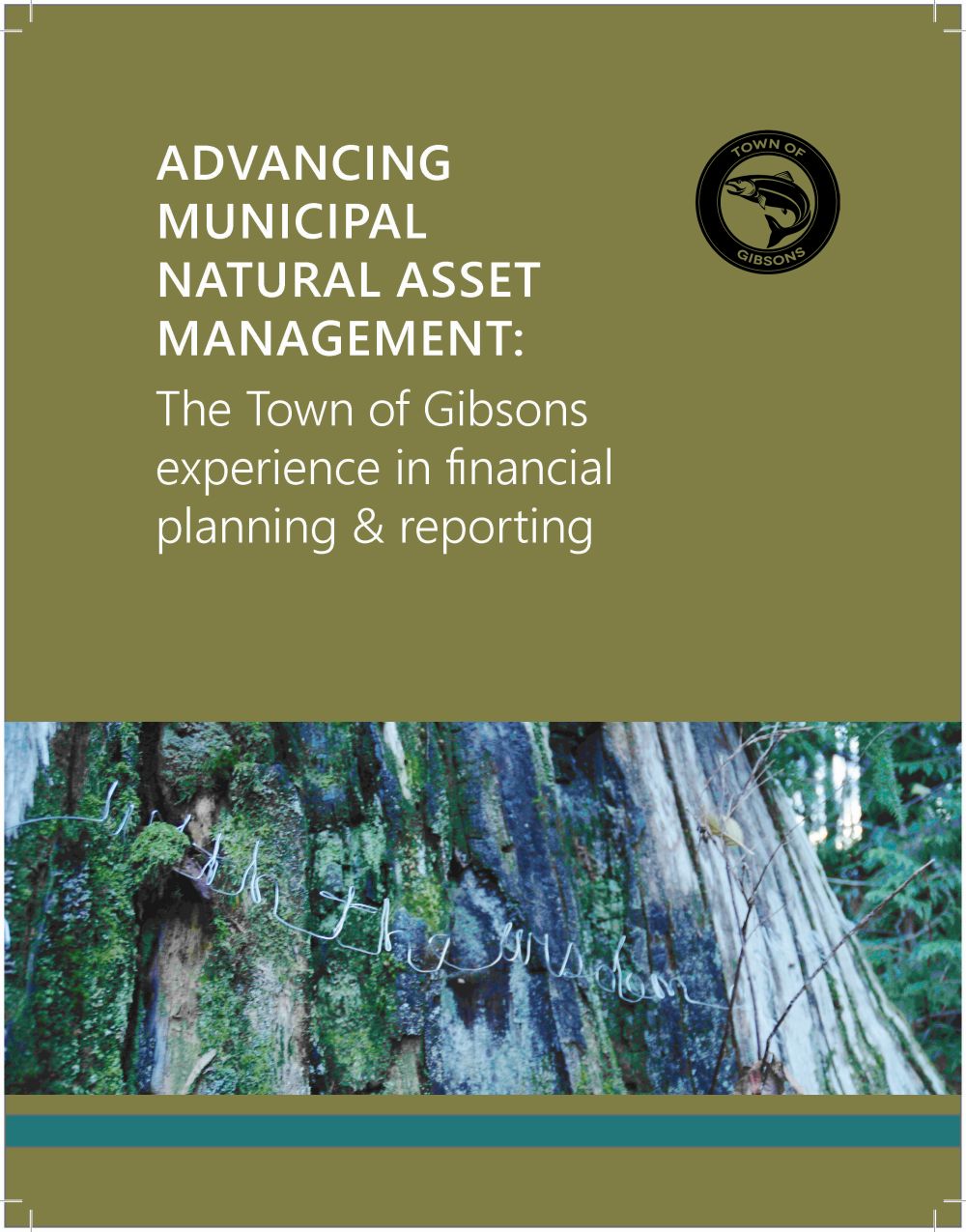Adopting Municipal Natural Asset Management (It’s Easier Than You Might Think!)
Note to Reader:
Gibsons is a town of 4,400 residents, situated at the south end of BC’s Sunshine Coast. In July 2014, it became the first municipality in North America – and possibly the world – to pass a municipal asset management policy that a) explicitly defines and recognizes natural assets as an asset class, and b) creates specific obligations to operate, maintain and replace natural assets alongside traditional capital assets, including having natural asset management strategies and financial resources to maintain them.
The Town has published a free, easy-to-read guide titled Advancing Municipal Natural Asset Management: The Town of Gibsons’ experience in financial planning and reporting.
The Town is a member of the Partnership for Water Sustainability in British Columbia, and a convening partner of the Municipal Natural Assets Initiative (MNAI). The Partnership and MNAI share a commitment to support local governments that wish to adopt policies and procedures concerning definition of natural assets and the value of services that can be drawn from them.
The goal of MNAI is to refine, replicate and scale up Gibsons’ innovative work in other communities. A goal of the Partnership is to inform, educate and build practitioner capacity within local government so that they can then successfully collaborate to implement a whole-system, water balance approach branded as Sustainable Watershed Systems, through Asset Management.

Aerial view of the Town of Gibsons on the Sunshine Coast, British Columbia
“We’re aiming to translate enthusiastic interest in our home-grown approach into real-world practice in municipalities and asset management organizations around the world,” says Emanuel Machado, CAO, Town of Gibsons
Nature as the Heart of Municipal Infrastructure
 “We get it. It can feel incredibly daunting to implement a significant change to your established systems – even when there’s clear evidence that change will almost certainly help improve decision-making, reduce asset funding requirements and advance your community’s resilience to climate change over the long-term,” states Emanuel Machado, the driving force behind the Municipal Natural Assets Initiative (MNAI).
“We get it. It can feel incredibly daunting to implement a significant change to your established systems – even when there’s clear evidence that change will almost certainly help improve decision-making, reduce asset funding requirements and advance your community’s resilience to climate change over the long-term,” states Emanuel Machado, the driving force behind the Municipal Natural Assets Initiative (MNAI).
“That’s why the Town of Gibsons, with strong support from the MNAI team was first inspired to create “Advancing Municipal Natural Asset Management: The Town of Gibsons’ experience in financial planning and reporting” – otherwise known as ‘Advancing MNAM’.
Free Financial Guide:
“Officially released in early spring, the free, easy-to-read financial guide is a follow-up to Towards an Eco-Asset Strategy in the Town of Gibsons which outlines our initial efforts to place nature, and the municipal services it provides, at the heart of Gibsons’ municipal infrastructure system.”
“The key concept is that natural assets (like our own Gibsons Aquifer) which deliver core civil services (such as the storage and filtration of drinking water) should be managed and accounted for in exactly the same way as engineered assets.
Move from Interest to Practice:
“It’s an innovative, timely idea that’s quickly gaining traction, as local governments around the world have come to recognize the importance of, and challenges associated with, creating robust, financially sustainable infrastructure.
“Now, with the release of Advancing MNAM, we’re aiming to translate enthusiastic interest in our home-grown approach into real-world practice in municipalities and asset management organizations around the world.”
Financial Planning vs Reporting: There is a Difference!
“In some cases, that means sharing little-known intelligence, such as the fact that federal and provincial governments now include natural assets as eligible funding categories. In other cases, the information is more experience-based,” continues Emanuel Machado.
“Once we’d officially defined nature as an asset, for example, we discovered we were able to amend our Development Cost Charges (DCCs) bylaw to allow us to collect DCCs for improvements to natural areas on those developments that are serviced directly or indirectly by the applicable natural assets.
Incorporating Nature is Easy:
“More important than describing some of the financial benefits of adopting MNAM, however, is our desire to show relevant parties, such as municipal asset managers, and financial and accounting staff, how easy it is to start incorporating natural assets into your asset management plan.
“A key to this is understanding the difference between financialplanning and financial reporting.”
“Currently, the Public Sector Accounting Board (PSAB), which creates a handbook to guide public sector accountants, excludes natural assets from being recognized as Tangible Capital Assets. However, just because natural assets may not be officially accounted for (yet), does not mean governments cannot (or should not) include them in their financial plans.
Getting Started:
“This could mean taking a straightforward step, such as integrating the costs associated with ongoing operations and maintenance of natural assets into your financial models.
“Or, it could mean committing to a more detailed process, such as developing a basic inventory of natural assets, describing the services they provide, estimating the value of those services and then conducting a simple risk assessment to help prioritize management efforts and focus.”
In Summary, It’s as Easy as One-Two-Three
“Either way, our message is this: do not to be overwhelmed.
“Start with a change in perspective; your assets include not only built or engineered infrastructure, but also natural assets that provide vital civil services.
“Next, adopt natural asset management practices that feel manageable and will positively impact your community.
“Then, build on and formalize that work as resources permit. In short, approach MNAM as you would any other worthwhile project – one step at a time.
“Step one? That’s the easiest of them all; download your free copies of Towards an Eco-Asset Strategy and Advancing Municipal Natural Asset Management today,” concludes Emanuel Machado.


